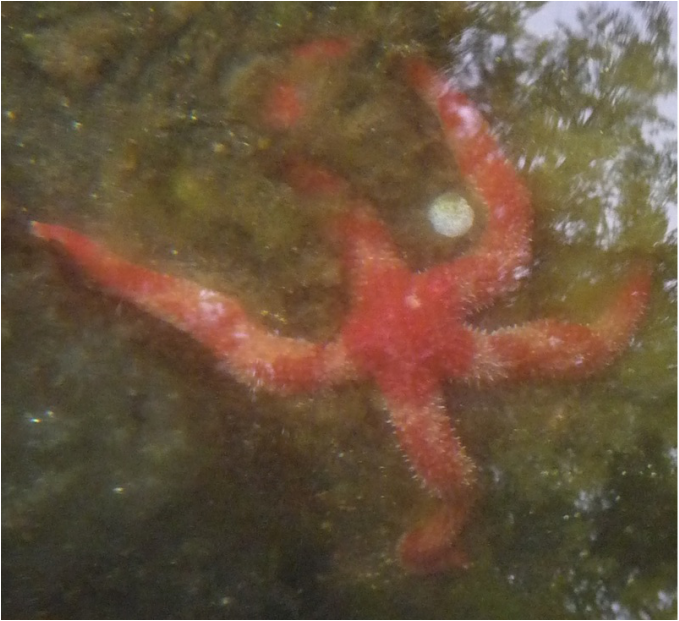Painted star, rainbow star, long-armed sea star,
red-banded sea star • Orthrasterias koehleri
Identification
The painted star is banded with reddish and white-cream and has five long flexible arms. It may occasionally be solid red, or even white or blue. It is covered in rows of prominent spines, which are usually white. This species reaches 50 cm in diameter. It may sometimes be found with less than 5 rays due to slow regeneration after loss of limb (see this example of extreme limb loss).
Habitat & Range
This species is generally subtidal and found to depths of 283 m, although it may be found in the intertidal as well. It inhabits most substrates, including mud, sand, gravel, and rock. Its range extends from the eastern Aleutian Islands and northern Alaska south to northern Mexico.
The painted star is banded with reddish and white-cream and has five long flexible arms. It may occasionally be solid red, or even white or blue. It is covered in rows of prominent spines, which are usually white. This species reaches 50 cm in diameter. It may sometimes be found with less than 5 rays due to slow regeneration after loss of limb (see this example of extreme limb loss).
Habitat & Range
This species is generally subtidal and found to depths of 283 m, although it may be found in the intertidal as well. It inhabits most substrates, including mud, sand, gravel, and rock. Its range extends from the eastern Aleutian Islands and northern Alaska south to northern Mexico.
References
Harbo, R. M. (1999). Whelks to whales: Coastal marine life of the Pacific Northwest. Madeira Park, BC: Harbour Publishing. P. 137.
Cowles, D. (2008). Orthasterias koehleri (de Loriol, 1897). Invertebrates of the Salish Sea. Rosario Beach Marine Laboratory. Accessed 12/02/2013.
Authors and editors of page
Chanda Brietzke and Brian Starzomski (2013).
Harbo, R. M. (1999). Whelks to whales: Coastal marine life of the Pacific Northwest. Madeira Park, BC: Harbour Publishing. P. 137.
Cowles, D. (2008). Orthasterias koehleri (de Loriol, 1897). Invertebrates of the Salish Sea. Rosario Beach Marine Laboratory. Accessed 12/02/2013.
Authors and editors of page
Chanda Brietzke and Brian Starzomski (2013).




